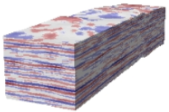- Rock Physics
- Rock Physics
Main | Mathematical Methods | CRAVA User Guide | Download
XML Model | Inversion | Estimation | Forward modelling | Rock Physics | Facies Predictions
The idea behind the rock physics template is to be able to model the density and elastic properties of a fluid-filled <rock> in a very flexible way, by selecting from and possibly combining many different rock physics theories. In order to do this, we need some basic building blocks. The basic building blocks here are <fluid>, <solid>, <dry-rock> (a solid with porosity, but no fluid) and <rock> (a combination of solid and fluid). In CRAVA, the rock physics models are used for generating the background model and covariance matrix used in the prior model, and for generating synthetic wells used for facies estimation.
The base structure of the rock physics template consists of the elements <reservoir>, <evolve>, <predefinition>, <rock> and <trend-cube>, each of which contains sub-elements. The sub-elements will be basic building blocks (e.g. <solid>, <fluid>, <dry-rock>), properties (e.g. temperature, pore-pressure, density, etc) and theories.
Example of setting up one <rock>:
<prior-model>
<rock-physics>
<rock>
<label>Channel</label>
<tabulated>
<vp>
<beta>
<mean>2000</mean>
<variance>200</variance>
<lower-limit>500</lower-limit>
<upper-limit>2000</upper-limit>
</beta>
</vp>
<vs>
<beta>
<mean>2000</mean>
<variance>300</variance>
</beta>
</vs>
<density>
<gaussian>
<mean>2</mean>
<variance>0.01</variance>
</gaussian>
</density>
<correlation-vp-vs> 0.7 </correlation-vp-vs>
<correlation-vp-density> 0.6 </correlation-vp-density>
<correlation-vs-density> 0.2 </correlation-vs-density>
</tabulated>
</rock>
</rock-physics>
</prior-model>
Example of rock physics model files can be downloaded here.


 How to get to NR
How to get to NR Share on social media
Share on social media Privacy policy
Privacy policy